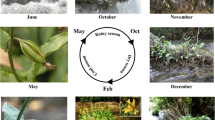Abstract
Polypleurum stylosum var. laciniata of the family Podostemaceae, is an endemic aquatic angiosperm, which grows on rocks in fast flowing rivers and streams in Kerala (India). The plant body is thalloid and it lacks the conventional differentiation into root and shoot and is attached to the rocks with the help of rhizoids. Vegetative growth occurs in submerged conditions and lowering of water table triggers flowering. Flower buds appear along the thallus margin enclosed by a spathella and sustained by two or three pairs of bracts. The ovary lacks a distinct style and the stigma is characteristically bifid. There are two stamens with their filaments fused, which keep on elongating and mingle with the stigma at maturity. High pollen–ovule and ovule–seed ratio indicate the high probability of plant establishment. Nearly 205 minute seeds are produced in a fruit. The embryo lacks plumule and radicle. In tissue culture, the seeds germinate and produce a green radical which sticks to the hard substratum by means of the epidermal outgrowths. The main thalloid plant body originates from the hypocotyl region as a bulge and grows into a prostrate branched thallus.



Similar content being viewed by others
References
Cook CDK, Rutishauser R (2007) Podostemaceae. In: Kubitzki K (ed) The families and genera of vascular plants, vol 9. Springer, Berlin, pp 304–344
Mohan Ram HY, Sehgal A (2001) Biology of Indian Podostemaceae. Phytomorphology. 51:365–391
Kato M (2004) Taxonomic studies of Podostemaceae of Thailand. 1. Hydrobryum and related genera with crustaceous roots (subfamily Podostemoideae). Acta Phytotaxon Geobot 55:133–165
Kato M (2006) Taxonomic studies of Podostemaceae of Thailand. 2. Subfamily Tristichoideae and subfamily Podostemoideae with ribbon-like roots. Acta Phytotaxon Geobot 57:1–54
Willis JC (1902) Studies in the morphology and ecology of the Podostemaceae of Ceylon and India. Ann R Bot Gard Peradeniya 1:267–465
Mathew CJ, Satheesh VK (1997) Taxonomy and distribution of Podostemaceae in Kerala, India. Aquatic Bot 57:243–274
Mathew CJ, Nileena CB, Jager-Zurn I (2003) Morphology and ecology of two new species of Polypleurum (Podostemaceae) from Kerala, India. Plant Syst Evol 237:209–217
Rutishauser R, Huber KA (1991) The developmental morphology of Indotristicha ramosissima (Podostemaceae–Tristichoideae). Plant Syst Evol 178:195–223
Rutishauser R (1997) Structural and developmental diversity in Podostemaceae (river-weed). Aquatic Bot 57:29–70
Murashige T, Skoog F (1962) A revised medium for rapid growth and bioassays with Tobacco tissues cultures. Physiol Plant 15:473–497
Vidyashankari B, Mohan Ram HY (1987) In vitro germination and origin of thallus in Griffithella hookeriana (Podostemaceae). Aquatic Bot 28:161–169
Went FAFC (1926) Untersuchungen über Podostemaceen III. Verh K Akad Wetensch 25:1–58
Sculthorpe MA (1967) The biology of aquatic vascular plants. Edward Arnold, London
Schnell R (1969) Contribution a l’etude des Podostemaceae de Guyana. Adansonia Ser 2 9:249–271
Jäger-Zürn I (1970) Morphologie der Podostemaceae I Tristicha trifaria (Bory ex Willd) Spreng. Beitr Biol Pflanz 47:11–52
Grubert M (1976) Podostemaceen-Studien. Teil 2 Untersuchungen über die Keimung. Bot Jahrb Syst 95:455–477
Schnell RAA, Cusset G (1963) Remarques sur la structure plantules des Podostémonacées. Adansonia 3:358–369
Nagendran CR (1983) Is the Podostemaceae thallus a root? Swamy Bot Club Newsl 2(4):104–109
Imaichi Ota MR, Kato M (2001) Developmental morphology of the thalloid Hydrobryum japonicum (Podostemaceae). Am J Bot 88:382–390
Kato M, Koi S, Kita Y (2004) A new foliose-rooted genus of Podostemaceae from Thailand with a note on root evolution. Acta Phytotaxon Geobot 55:65–73
Jäger-Zürn I (2000) Crustose root and root-borne shoots of Zeylanidium olivaceum (Podostemaceae–Podostemoideae). Flora 195:200–227
Jäger-Zürn I (2000) Developmental morphology of Podostemum munnarensis (Podostemaceae–Podostemoideae) as compare to related taxa. Bot Jahrb Syst 122:341–355
Koi S, Kita Y, Kato M (2008) Paracladopus chanthaburiensis, a new species of Podostemaceae from Thailand, with notes on its morphology, phylogeny and distribution. Taxon 57:201–210
Erdtman G (1966) Pollen morphology and plant taxonomy—angiosperms. EJ Brill, Leiden
Char MBS, Nagendran CR (1974) Remarkable similarities in pollen dynamics. Curr Sci 43:461–462
Dahlgren RMT, Cliford HT (1982) The monocotyledons—a comparative study. Academic Press, London
Bove CP, Philbrick CT, Costa WJEM (2011) Taxonomy, distribution and emended description of the Neotropical Podostemacean genus Lophogyne. Brittonia 63:156–160
Pfeifer E, Grob V, Thiv M, Rutishauser R (2009) Stonesia ghoguei, peculiar morphology of a new Cameroonian species (Podostemaceae, Podostemoideae). Novon 19:102–116
Ghogue JP, Ameka GK, Grob V, Huber KA, Pfeifer E, Rutishauser R (2009) Enigmatic morphology of Djinga felicis (Podostemaceae–Podostemoideae) a badly known endemic from northwestern Cameroon. Bot J Linn Soc 160:64–81
Philbrick CT (1984) Aspects of floral biology, breeding system and seed and seedling biology in Podostemum ceratophyllum (Podostemaceae). Syst Bot 9(2):166–174
Rutishauser R, Grubert M (1994) The architecture of Mourera fluviatilis (Podostemaceae). Bot Helv 104:179–194
Sehgal A, Mohan Ram HY, Bhatt JR (1993) In-vitro germination, growth, morphogenesis and flowering of an aquatic angiosperm, Polypleurum stylosum (Podostemaceae). Aquat Bot 45:269–283
Mohan Ram HY, Sehgal A (1997) In vitro studies on developmental morphology of Indian Podostemaceae. Aquat Bot 57:97–132
Acknowledgments
The authors are grateful to the University of Delhi and Department of Science and Technology, New Delhi for providing financial support in the form of DST-PURSE Project on Podostemaceae.
Author information
Authors and Affiliations
Corresponding author
Ethics declarations
Conflict of interest
The work is presented in the manuscript with the consent of all authors. The authors declare that they have no conflict of interest.
Rights and permissions
About this article
Cite this article
M., L., Uniyal, P.L. & Tandon, R. Studies on the Morphology and In Vitro Seed Germination of Polypleurum stylosum var. laciniata (Podostemaceae). Proc. Natl. Acad. Sci., India, Sect. B Biol. Sci. 87, 1177–1183 (2017). https://doi.org/10.1007/s40011-015-0687-6
Received:
Revised:
Accepted:
Published:
Issue Date:
DOI: https://doi.org/10.1007/s40011-015-0687-6




